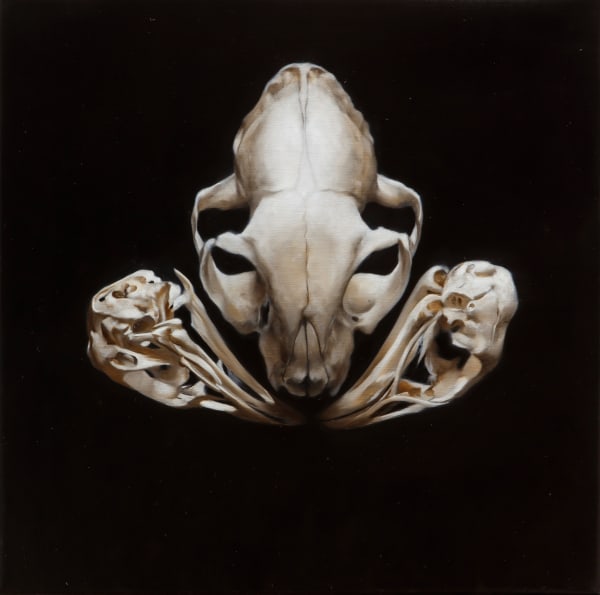Markus Åkesson | Weaver's Grove, The Oracle Bones
Encountering Markus Åkesson's paintings is like a crash course in art history; there are references to 19th century realist painting, the Pre-Raphaelites, Renaissance masters Hans Holbein the Younger and Albrecht Dürer, chinoiserie, and art nouveau. And the majority of these references appear on the draped fabrics that cover Åkesson's models.
Åkesson's fascination with patterns, drapery, light and shadow can be observed in his early paintings. But it wasn't until a couple of years ago that he began working on his now-familiar motifs of veiled figures posing against a background of the same, highly decorated fabric – a series he called "Now You See Me". In the exhibition Weaver's Grove, the Oracle Bones, Åkesson weaves together works from this series with intimate still lifes depicting plants and animal bones.
Åkesson's hyperrealist work skillfully employs traditional painterly methods such as glazing and chiaroscuro. Subject matter moves mysteriously through beauty and death, the mythological and the existential. The motifs in the exhibition are repeated, reflecting each other in Rorschach-like compositions. Patterns, interlocking threads, draperies. The petals in the paintings of hibiscus and peony resemble flowing sheets of fabric. Two glass pieces, meticulously cut to the form of faces, mimicking each other.
The exhibition title – Weaver's Grove – refers to several aspects of Åkesson's work: the fabrics, the stories that the images weave together, and the interplay between works in the exhibition. "The Oracle Bones" refers to the suite with the same name. Oracle bones were used as a form of divination in ancient China, and the earliest surviving examples date back to the Shang Dynasty. Traditionally, questions about the future, crop planting, and military endeavors were carved onto animal bones that were heated until they cracked. Diviners would then interpret the patterns and cracks that appeared.
A key work in the exhibition is the two-meter-high depiction of a bird skull, Ibis (2023). The ibis bird was a symbol of the Egyptian god Thoth who, paradoxically, was associated with both dry logic and mystical adjuration. This duality can be recognized in Åkesson's esoteric imagery that allows us to see the clear beauty in details while leaving us filled with wonder.
Markus Åkesson (b. 1975) lives and works in Nybro, Sweden. His works have been exhibited in a large number of exhibitions in Paris, Berlin, Brussels, London, Vilnius, and Sweden. Previous solo exhibition venues include Solliden Royal Palace, Öland (2023), Galerie Da-End, Paris (2022), Market Art Fair, Liljevalchs Konsthall, Stockholm (2022), VIDA Museum, Borgholm (2021), Berg Gallery, Stochkolm (2021), and Kalmar Konstmuseum (2018). Åkesson is represented in the collections of Fondation Francès (FR), Public Art Agency of Sweden (SE), VIDA Museum (SE), Smålands Museum (SE), Château du Rivau (FR), Alice Walton Family Collection (US), and Jacques-Antoine Granjon Collection (FR), among others.
Join our mailing list
* denotes required fields
We will process the personal data you have supplied in accordance with our privacy policy (available on request). You can unsubscribe or change your preferences at any time by clicking the link in our emails.






















